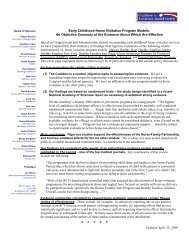Do Early Childhood Intervention Programs Really Work? - Social ...
Do Early Childhood Intervention Programs Really Work? - Social ...
Do Early Childhood Intervention Programs Really Work? - Social ...
Create successful ePaper yourself
Turn your PDF publications into a flip-book with our unique Google optimized e-Paper software.
The program itself was the archetypal early intervention program for<br />
preschoolers. Three and four year old children participated for one or two school years.<br />
The school applied classic principles of child development to create a nurturing<br />
environment which would foster social, emotional, and cognitive growth. Studentteacher<br />
ratios were very low, with four teachers in each class of 20-25 children.<br />
Teachers made weekly 90 minute home visits to every family. All teachers were certified<br />
in both early childhood and special education.<br />
The most recent follow-up was done when the participants were 27 years old,<br />
more than two decades after they completed the program (Schweinhart et al., 1993). By<br />
that age, the program had a number of large effects, several of which were truly dramatic.<br />
It quadrupled the proportion of individuals who were earning more than $2,000 per<br />
month, from 7% to 29%. It almost tripled home ownership, raising it from 13% to 36%.<br />
It reduced the proportion who had ever received welfare by a quarter, from 80% to 59%.<br />
It quintupled the proportion of women who were married, from 8% to 40%. (It had no<br />
effect on the percentage of men who were married, but since men tend to marry later than<br />
women, it would not be surprising if such an impact showed up later.) It decreased the<br />
proportion of women who had ever born a child out-of-wedlock by almost a third, from<br />
83% to 57%. It cut the total number of arrests in half. And in what may be the single<br />
most extraordinary gain ever achieved by a social program, it reduced the rate of hard<br />
core criminality (defined as an individual having five or more arrests) by four-fifths, from<br />
35% to 7%.<br />
All told, the program was extremely cost effective. It generated $7.16 in benefits<br />
for society as a whole for each dollar spent (assuming a 3% discount rate). And this<br />
10




